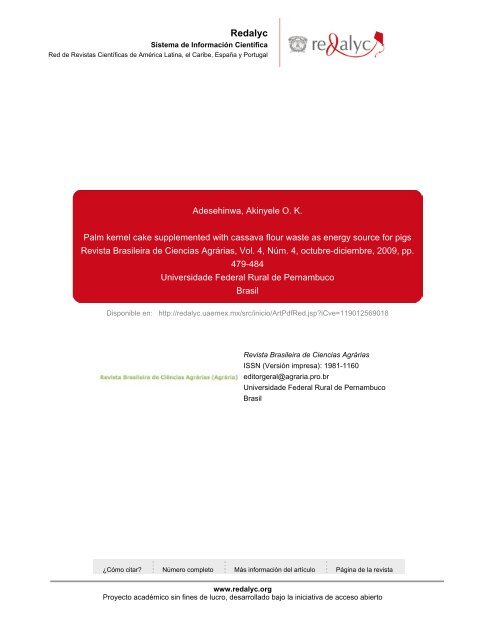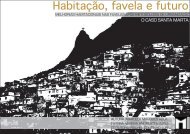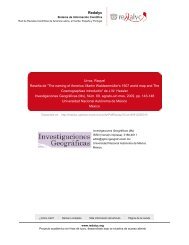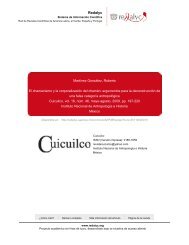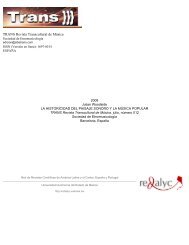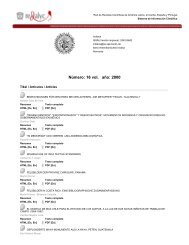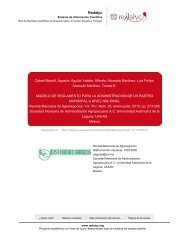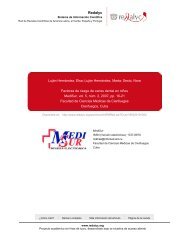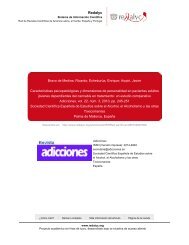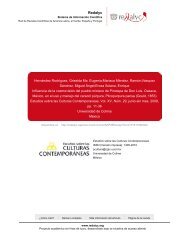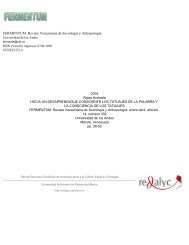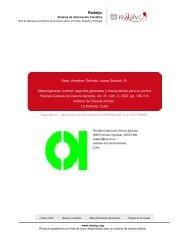Redalyc.Palm kernel cake supplemented with cassava flour waste ...
Redalyc.Palm kernel cake supplemented with cassava flour waste ...
Redalyc.Palm kernel cake supplemented with cassava flour waste ...
Create successful ePaper yourself
Turn your PDF publications into a flip-book with our unique Google optimized e-Paper software.
<strong>Redalyc</strong><br />
Sistema de Información Científica<br />
Red de Revistas Científicas de América Latina, el Caribe, España y Portugal<br />
Adesehinwa, Akinyele O. K.<br />
<strong>Palm</strong> <strong>kernel</strong> <strong>cake</strong> <strong>supplemented</strong> <strong>with</strong> <strong>cassava</strong> <strong>flour</strong> <strong>waste</strong> as energy source for pigs<br />
Revista Brasileira de Ciencias Agrárias, Vol. 4, Núm. 4, octubre-diciembre, 2009, pp.<br />
479-484<br />
Universidade Federal Rural de Pernambuco<br />
Brasil<br />
Disponible en: http://redalyc.uaemex.mx/src/inicio/ArtPdfRed.jsp?iCve=119012569018<br />
Revista Brasileira de Ciencias Agrárias<br />
ISSN (Versión impresa): 1981-1160<br />
editorgeral@agraria.pro.br<br />
Universidade Federal Rural de Pernambuco<br />
Brasil<br />
¿Cómo citar? Número completo Más información del artículo Página de la revista<br />
www.redalyc.org<br />
Proyecto académico sin fines de lucro, desarrollado bajo la iniciativa de acceso abierto
Revista Brasileira de Ciências Agrárias<br />
v.4, n.4, p.479-484, out.-dez., 2009<br />
Recife, PE, UFRPE. www.agraria.ufrpe.br<br />
Protocolo 540 - 27/03/2009 • Aprovado em 30/09/2009<br />
Akinyele O. K. Adesehinwa 1<br />
1 Obafemi Awolowo University, Institute of<br />
Agricultural Research and Training, P.M.B. 5029,<br />
Moor Plantation, Ibadan, Nigeria. E-mail:<br />
aokadesehinwa@yahoo.com<br />
<strong>Palm</strong> <strong>kernel</strong> <strong>cake</strong> <strong>supplemented</strong> <strong>with</strong><br />
<strong>cassava</strong> <strong>flour</strong> <strong>waste</strong> as energy source<br />
for pigs<br />
ABSTRACT<br />
Thirty six (36) growing crossbred (Large White X Landrace) pigs (16.14±0.67kg) were used to determine<br />
the effect of replacing maize by palm <strong>kernel</strong> <strong>cake</strong> (PKC) <strong>supplemented</strong> <strong>with</strong> two levels of <strong>cassava</strong><br />
<strong>flour</strong> <strong>waste</strong> (CFW) on the chemical composition of the diets, performance, economy of the production,<br />
serum metabolites and hematological values of the growing pigs. Two levels of CFW<br />
(20%PKC+10%CFW and 20%PKC+20%CFW) were included in the diets of growing pigs to replace<br />
40% maize inclusion on a weight to weight basis in the 42-day feeding trial. The chemical composition<br />
of the diets revealed the increase of 74.4-77.6% in the crude fibre content over the control<br />
diet <strong>with</strong> a resultant decrease 10.9-11.7% in the energy concentrations in the test diets. The average<br />
daily weight gains, feed efficiency and protein utilization were comparable between the treatment<br />
groups. The cost of feed / kg live weight of pigs reduced (P
480 A. O. K. Adesehinwa<br />
INTRODUCTION<br />
Swine production is a growing enterprise in Nigeria, but<br />
the major constraint has been the high cost of feeding because<br />
of the high cost and inconsistent availability of the<br />
conventional energy and protein sources. This could be as<br />
high as up to 75-80% in the fattening herd and 60-65% in the<br />
breeding herd (Tewe, 1997). This situation is partly the result<br />
of competition between man and livestock for some food and<br />
feed ingredients, particularly, energy sources, such as maize.<br />
It would therefore be economically expedient to explore the<br />
use of non-conventional feed resources (NCFR) or agro-industrial<br />
by-product (AIBP), which are abundant and cheap<br />
(Okai et al., 2005). These are regarded as unused feed resources<br />
that are useless for human consumption or nutrition hence,<br />
non-competitive (Adesehinwa, 2008).<br />
<strong>Palm</strong> <strong>kernel</strong> <strong>cake</strong> (PKC) has been reported as a high energy<br />
and cost effective feed ingredient that can be utilized in<br />
ration formulations for livestock feeding (Zahari & Alimon,<br />
2006; Adesehinwa, 2007). It is abundant in the tropical areas<br />
of the world and it is an excellent feed ingredient for animal<br />
production due to its availability and low cost (Orunmuyi et<br />
al., 2006). The proximate analysis has showed that it can be<br />
classified as energy feed, <strong>with</strong> the chemical component, very<br />
similar to that of corn gluten or rice bran (Alimon, 2006; Adesehinwa,<br />
2007). Being a by-product from the palm oil industry,<br />
it could be comparatively high in oil content (depending<br />
on the level of processing) but dry and gritty. Its worthy of<br />
note that its earlier use as feed ingredient was mainly by ruminants<br />
(Chandrasekariah et al., 2001) because of its fibrous<br />
nature (16-18% and above, depending on type of processing<br />
method), low palatability and low availability of amino acids<br />
and energy, hence considered unsuitable for non-ruminants.<br />
The shell content, which may reach as high as 10%, contributes<br />
a great deal to its high crude fibre content (Alimon,<br />
2006). Analysis has shown that more than 60% of PKC is cell<br />
wall component, consisting of 58% of mannan, 12% of cellulose<br />
and 4% of xylan (Jaafar & Javis, 1992). Pigs are however<br />
knew to have large caecum, hence, could be able to digest<br />
the fibre in PKC to a considerable extent. The<br />
metabolizable energy (ME) of 10-10.5 MJ kg -1 reported for<br />
pigs is higher than for poultry (6.5-7.5 MJ kg -1 ) (Alimon, 2006).<br />
Inclusion rate of 20-25% has been successfully used in Malaysia<br />
for growing-finishing pigs (Zahari & Alimon, 2006) while<br />
25-35% inclusion rate has been reported for the same class<br />
of pigs in Ghana (Rhule, 1996). However, intake may be depressed<br />
if inclusion rate is higher than 30%.<br />
The crude fibre content of most samples of PKC, 16-18%,<br />
is acceptable to most ruminants, but considered high for nonruminants.<br />
Hence, the reason it was adjudged not to be suitable<br />
if included at high levels in poultry or pig diets (Alimon,<br />
2006; Adesehinwa et al., 2008). Improving the nutritive<br />
value of PKC for monogastric animals may therefore require<br />
supplementation <strong>with</strong> a more digestible ingredient, such as<br />
<strong>cassava</strong> <strong>flour</strong> or meal.<br />
Cassava <strong>flour</strong> <strong>waste</strong>/root meal is another agro-industrial<br />
by-product that could be exploited as animal feed. It is however,<br />
noteworthy that Nigeria is the leading world producer of<br />
Rev. Bras. Ciênc. Agrár. Recife, v.4, n.4, p.479-484, 2009<br />
<strong>cassava</strong> (Orunmuyi et al., 2006) and its availability in Nigeria<br />
is non-seasonal. Several researchers had earlier confirmed the<br />
suitability of <strong>cassava</strong> for pig feeding and the potential of<br />
<strong>cassava</strong> meal as a feed substitute for maize, for all classes of<br />
pigs (Adesehinwa, 2008; Adesehinwa et al., 1998). However,<br />
certain precautions need be taken to guarantee satisfactory<br />
performance of animals on <strong>cassava</strong> meal diets. These was<br />
reported to include the removal of cyanide through boiling,<br />
drying, grating, soaking, fermenting or a combination of these<br />
processes to produce final products containing not more<br />
than 100 ppm HCN, and the prevention of microbial activity<br />
during sun-drying, particularly in a humid environment (Tewe<br />
& Egbunike, 1988). High cyanide levels and the presence of<br />
microorganisms have been demonstrated to reduce performance<br />
and induce haematological changes of growing pigs fed<br />
sun-dried <strong>cassava</strong> based rations (Tewe, 2006).<br />
Cassava meal is the powdered residue of the chips and<br />
roots after processing to extract edible starch. It is generally<br />
inferior in quality to chips, pellets and broken roots <strong>with</strong> lower<br />
starch content (Tewe, 2006). Lack of protein and essential<br />
fatty acids that characterize the <strong>cassava</strong> <strong>flour</strong> can be amply<br />
enriched <strong>with</strong> PKC. A mixture of PKC and CFW at the ratio<br />
of 1:1 or 2:1 is being experimented as a replacement for maize,<br />
the conventional energy source, in an attempt to meet the<br />
need of small-scale farmers who produce their own feedstuff.<br />
The aim of this study was therefore, to replace the maize fraction<br />
of the diets of growing pigs <strong>with</strong> PKC <strong>supplemented</strong> <strong>with</strong><br />
two levels of CFW.<br />
MATERIAL AND METHOD<br />
The experiment was carried out at the Swine Research Unit<br />
of the Institute of Agricultural Research and Training, Obafemi<br />
Awolowo University, Moor Plantation, Ibadan.<br />
Sources of Ingredients<br />
The test ingredients (PKC and CFW) and other feed ingredients<br />
used in this study were sourced locally, similar to<br />
farmers’ sources. The PKC used is a product of the cottage<br />
industries in Nigeria that uses hydraulic press method for oil<br />
extraction from palm <strong>kernel</strong>, while the CFW is <strong>waste</strong> <strong>flour</strong> from<br />
local <strong>cassava</strong> <strong>flour</strong> mill.<br />
Experimental Diets and Animal<br />
The utilization of palm <strong>kernel</strong> <strong>cake</strong> <strong>supplemented</strong> <strong>with</strong> <strong>cassava</strong><br />
<strong>flour</strong> <strong>waste</strong> in the diets of the growing pigs was investigated<br />
using thirty six growing crossbred (Large White X<br />
Landrace) pigs <strong>with</strong> average initial live weight of 16.14±0.67kg.<br />
They were injected <strong>with</strong> Ivomec® (Ivermectin) subcutaneously<br />
against endo-and ecto-parasites (1ml/50kg live weight) and<br />
were randomly allotted to the three dietary treatment groups<br />
in a completely randomized design. The diets contained 20%<br />
PKC+10% CFW and 20% PKC+20% CFW as a replacement,<br />
weight for weight, for the 40% maize contained in the control<br />
diet (Table 1).<br />
The diets were neither formulated to be isonitrogenous nor<br />
isocaloric but the pigs were fed <strong>with</strong> equal quantities of the
<strong>Palm</strong> <strong>kernel</strong> <strong>cake</strong> <strong>supplemented</strong> <strong>with</strong> <strong>cassava</strong> <strong>flour</strong> <strong>waste</strong> as energy source for pigs<br />
Table 1. Proximate chemical compositions and estimated metabolizable energy<br />
of palm <strong>kernel</strong> <strong>cake</strong> (PKC) and <strong>cassava</strong> <strong>flour</strong> <strong>waste</strong> (CFW)<br />
Tabela 1. Composição química aproximada e estimativa de energia<br />
metabolizável do farelo de palmiste (PKC) e do farelo residual de mandioca<br />
(CFW)<br />
Components PKC CFW<br />
Dry Matter (%) 92.65 89.75<br />
Crude Protein (%) 15.15 2.10<br />
Crude Fibre (%) 20.71 1.82<br />
Ether Extract (%) 4.69 0.36<br />
Ash (%) 4.33 10.50<br />
Nitrogen Free Extract (%) 54.15 85.22<br />
Estimated Metabolizable Energy (kcal kg -1)* 2,844 30.15<br />
* Calculated <strong>with</strong> equation reported by Adesehinwa (2008)<br />
feed according to their daily requirements (NRC, 1988). There<br />
were six replicates of two animals per treatment group. They<br />
were allowed ad libitum access to water in the concrete-floored<br />
pens where they were kept throughout the 42-day duration<br />
of the trial and the performance were monitored.<br />
Chemical Analysis<br />
The test ingredients and feed samples were analyzed for<br />
the proximate chemical composition using the recommended<br />
procedures of Association of Official Analytical Chemists<br />
(A.O.A.C., 1990). The metabolizable energy content of the diets<br />
was determined <strong>with</strong> the prediction equation reported by<br />
Adesehinwa (2008) based on proximate composition. The<br />
proximate chemical components and metabolizable energies<br />
of the diets on dry matter basis are showed on Table 1.<br />
Cost Estimations<br />
The costs of ingredients at the time of purchase were used<br />
to calculate the total cost of feed/100kg of the diet. This was<br />
further used in the calculation of the cost of feed consumed<br />
and the cost of feed/kg live weight gained.<br />
Hematology and Serum Biochemistry<br />
Six of the twelve experimental pigs in each of the three<br />
dietary treatment groups were randomly selected for blood<br />
collection at the end of the feeding trial. The bleeding was<br />
done in the morning before feeding and 10 ml of blood was<br />
obtained from the jugular vein into two sample bottles using<br />
a sterilized needle and syringe (Adesehinwa, 2007). The blood<br />
samples for serum analysis were allowed to clot before centrifuging<br />
to obtain the serum. The separated sera were decanted<br />
into bijoh bottles and stored at – 10 0 C until analyzed.<br />
The serum metabolites (total protein, albumin, globulin, creatinine,<br />
urea, cholesterol and glucose) were determined as<br />
described by Adesehinwa (2007). The blood samples for the<br />
hematological studies were collected in sample bottles <strong>with</strong><br />
EDTA before being analyzed its hemoglobin, red blood cells<br />
(RBC), packed cell volume (PCV) and white blood cells (WBC)<br />
contents as described by Mafuvadze & Erlwanger (2007);<br />
Tripathi et al. (2008).<br />
Statistical Analysis<br />
All the data obtained were subjected to statistical analysis<br />
using analysis of variance (ANOVA) procedure of SAS<br />
481<br />
(1999). The significant treatment means were compared using<br />
the New Duncan Multiple Range test option of the same<br />
software.<br />
RESULTS AND DISCUSSION<br />
Chemical Composition<br />
The chemical composition of the test ingredients (PKC and<br />
CFW) and diets used in this study are showed in Tables 1<br />
and 2 respectively. The proximate analysis of the PKC was<br />
similar to that used by Alimon (2006). Cassava <strong>flour</strong> <strong>waste</strong>,<br />
on the other hand, had a composition that was different from<br />
that reported by Tegbe et al. (1995). The slight variations<br />
observed in some of the components could be attributed to<br />
the different methods of processing and storage. Alimon<br />
(2006) had classified PKC as an energy source, because of<br />
the similarity of its chemical composition to that of the corn<br />
gluten or rice bran and its low protein content (16-18%). The<br />
crude protein, fibre and the fat contents of CFW were very<br />
low compared to the PKC. However, the lack of protein and<br />
essential fatty acids that characterize the <strong>cassava</strong> <strong>flour</strong> seem<br />
to have been compensated <strong>with</strong> the PKC when both ingredients<br />
were incorporated in the diets. It was also noticed that<br />
PKC, being slightly fatty, masked the powdery nature of the<br />
CFW.<br />
Table 2. Gross and calculated compositions of the experimental diets of growing<br />
pigs containing palm <strong>kernel</strong> <strong>cake</strong> <strong>supplemented</strong> <strong>with</strong> two levels of <strong>cassava</strong><br />
<strong>flour</strong> <strong>waste</strong><br />
Tabela 2. Composições bruta e calculada das dietas experimentais para suínos<br />
em crescimento contendo farelo de palmiste suplementado com dois níveis<br />
de farelo residual de mandioca<br />
Ingredients Control PKC+10%CFW PKC+20%CFW<br />
Maize 40.0 10.0 0.0<br />
Cassava Flour Waste 0.0 10.0 20.0<br />
<strong>Palm</strong> Kernel Cake 0.0 20.0 20.0<br />
Maize Offal 15.0 15.0 15.0<br />
Wheat Offal 25.0 25.0 25.0<br />
Groundnut Cake 14.0 14.0 14.0<br />
Blood Meal 3.0 3.0 3.0<br />
Bone Meal 2.25 2.25 2.25<br />
Salt 0.50 0.50 0.50<br />
Premix* 0.25 0.25 0.25<br />
Calculated proximate compositions<br />
Crude Protein (%) 17.39 18.39 17.79<br />
Crude Fibre(%) 4.77 8.32 8.47<br />
Ether Extract (%) 3.63 2.68 2.33<br />
Estimated Metabolizable<br />
Energy (kcal kg-1 )**<br />
2,669.30 2,379.70 2,356.50<br />
* Pfizer Agricare Grower Premix supplied the following per kg diet: Vit A 10,000,000 IU; Vit D 3 2,000,000<br />
IU; Vit E 8,000 IU; Vit K 2,000mg;Vit B 1 2,000 mg; Vit B 2 5,500mg; Vit B 6 1,200 mg; Vit B 12 12 mg; Biotin<br />
30 mg; Folic Acid 600 mg; Niacin 10,000 mg; Pantothenic Acid 7,000mg; Choline chloride 500,000 mg;<br />
Vit C 10,000mg; Iron 60,000 mg; Mn 80,000 mg; Cu 8,00mg; Zn 50,000 mg; Iodine 2,000 mg; Cobalt<br />
450 mg; Selenium 100 mg; Mg 100,000 mg; Anti Oxidant 6,000 mg; ** Calculated after Morgan et al.<br />
(1975)<br />
The crude fibre contents of the diets increased <strong>with</strong> the<br />
inclusion of PKC as a replacement for maize while the maizebased<br />
control diet had the least value. However, the increased<br />
crude fibre content diluted the energy contents of the test<br />
Rev. Bras. Ciênc. Agrár. Recife, v.4, n.4, p.479-484, 2009
482 A. O. K. Adesehinwa<br />
diets. The resultant effect of replacing the high energy maize<br />
<strong>with</strong> PKC, a fibrous ingredient, an attribute of most AIBP<br />
(Adesehinwa, 2008), could explain the comparably lower energy<br />
value obtained for the PKC+CFW diets.<br />
Performance Characteristics<br />
The summary of the performance characteristics as affected<br />
by the different diets is showed in Table 3. The daily<br />
weight gains and feed:gain ratio were not significantly (P>0.05)<br />
affected at both levels of inclusion of PKC + CFW. This was<br />
in agreement <strong>with</strong> the findings of Adesehinwa (2007) who<br />
observed no adverse effect on dry matter intake, weight gain<br />
and feed conversion ratio as a result of the addition of PKC<br />
to the diets of growing pigs. The results thus suggested that<br />
the lysine and amino acid (AA) levels available in the diets<br />
could be considered adequate <strong>with</strong> the comparable gains of<br />
the pigs on the PKC diets to the control. A linear relationship<br />
exists between weight gain and dietary protein. It should be<br />
noted that a decreasing trend in lysine content resulting from<br />
reduced availability of AA in diets containing PKC was expected<br />
(Rhule, 1996). The comparable gains obtained <strong>with</strong> the<br />
replacement of 50 % of the maize content in the control diet<br />
<strong>with</strong> PKC and the two levels of CFW is evidence that both<br />
test diets were able to meet the requirements of this class of<br />
pigs.<br />
Table 3. Performance of growing pigs fed diets containing palm <strong>kernel</strong> <strong>cake</strong><br />
<strong>supplemented</strong> <strong>with</strong> two levels of <strong>cassava</strong> <strong>flour</strong> <strong>waste</strong><br />
Tabela 3. Desempenho de suínos alimentados com dietas contendo farelo de<br />
palmiste suplementado com dois níveis de farelo residual de mandioca<br />
Parameters Control PKC+10%CFW PKC+20%CFW SEM<br />
Average Initial live weight (kg) 16.50 16.17 15.75 0.67<br />
Average Final live weight (kg) 30.17 32.50 31.92 1.30<br />
Average Daily<br />
weight gain (kg)<br />
0.33 0.39 0.38 0.03<br />
Average Daily<br />
Feed Intake (kg)<br />
1.17 1.17 1.17 0.00<br />
Average Daily Crude<br />
Protein Intake (kg)<br />
0.21 0.23 0.22 0.01<br />
Feed Conversion Ratio<br />
(Feed:Gain)<br />
3.99 3.64 3.47 0.23<br />
Protein Efficiency Ratio (PER) 1.48 1.68 1.57 0.10<br />
The efficiency of protein and feed utilization was reported<br />
to decrease <strong>with</strong> increased fibre content in diets (Adesehinwa,<br />
2007) resulting from reduced digestibility and leading to low<br />
availability of AAs and energy of the diets. This was expected,<br />
taking into consideration the increased fibre contents of<br />
the PKC diets (Table 2) but the efficiencies of feed and protein<br />
utilization observed in this study were not significantly<br />
(P>0.05) affected by the dietary treatments. This is in agreement<br />
<strong>with</strong> earlier findings in related works by Rhule (1996)<br />
and Adesehinwa (2007), where no adverse effect was recorded<br />
in dry matter intake, body weight gains and feed efficiency<br />
as a result of the addition of PKC to the diets of the<br />
growing crossbred pigs.<br />
The use of <strong>cassava</strong> in commercial livestock feeding has<br />
been limited by some factors, notably, dustiness, low protein<br />
content, hyrocyanic acid and economic of its mixture into the<br />
Rev. Bras. Ciênc. Agrár. Recife, v.4, n.4, p.479-484, 2009<br />
commercial livestock feeds (Tewe & Egbunike, 1988). However,<br />
its use in this study in combination <strong>with</strong> PKC, a relatively<br />
higher protein and fat feedstuff, may be responsible for the<br />
enhanced performance of the pigs. Iyayi & Tewe (1988) had<br />
reported adequacy of <strong>cassava</strong> peel <strong>supplemented</strong> <strong>with</strong> protein<br />
sources in place of maize for growing pigs.<br />
Economy of Production<br />
The inclusion of PKC as a replacement for maize resulted<br />
in 25-32% reduction in the feed cost per kg and a significantly<br />
(P
<strong>Palm</strong> <strong>kernel</strong> <strong>cake</strong> <strong>supplemented</strong> <strong>with</strong> <strong>cassava</strong> <strong>flour</strong> <strong>waste</strong> as energy source for pigs<br />
Table 6. Haemoglobin values of growing pigs fed diets containing palm <strong>kernel</strong><br />
<strong>cake</strong> <strong>supplemented</strong> <strong>with</strong> two levels of <strong>cassava</strong> <strong>flour</strong> <strong>waste</strong><br />
Parameters Packed Cell Control PKC+10%CFW PKC+20%CFW SEM<br />
Volume (PCV) % 38.75 39.00 39.50 0.62<br />
Red Blood Cell (RBC) x106µl 7.81 7.56 7.23 0.17<br />
Hemoglobin (Hb) g dl-1 11.86 11.96 12.06 0.18<br />
Total White Blood<br />
Cells (WBC) x103µl Tabela 6. Valores de hemoglobina de suínos alimentados com dietas contendo<br />
farelo de palmiste suplementado com dois níveis de farelo residual de<br />
mandioca<br />
21,150 19,025 19,863 734.03<br />
has been established. Nutrition, especially, dietary protein<br />
intake is known to affect the live weight and haematological<br />
parameters of animals (Mafuvadze & Erlwanger, 2007). Gouache<br />
et al. (1991) reported lowered albumin content to be specifically<br />
influenced by dietary protein shortage.<br />
Dietary protein quality is dependent upon the adequacy<br />
and balance of the ten indispensable amino acids (IAA). A<br />
deficiency of one or more of the IAA will not only results in<br />
poor growth and other productive functions but may also<br />
lower disease resistance (Tripathi et al., 2008). Reduction in<br />
concentrations of erythrocytic parameters (such as PCV, RBC<br />
counts and Hb concentration) and elevation in MCV are indications<br />
of macrocytic (regenerative) anaemia emanating<br />
from increased destruction and subsequent enhanced erythropoiesis<br />
at liver, spleen and kidneys (Tripathi et al., 2008).<br />
However, this was not the case in this study as the total protein,<br />
albumin, globulin and hematological parameters were not<br />
significantly (P>0.05) influenced by the dietary treatments. It<br />
suffices to say that the nutrient profile of the diets was adequate<br />
to support the performance of the pigs.<br />
Proteins form the basic unit of cells and other substances<br />
that are necessary for body building, repairs and maintenance<br />
of homeostasis, regulation of vital body functions, energy<br />
source and defense against infectious agents (Adesehinwa,<br />
2008). Protein deficiency has been reported to reduce most<br />
haematological and serum parameters (Mafuvadze & Erlwanger,<br />
2007) through reduced or impaired synthesis of the blood<br />
cells which are largely proteinaceous. The total serum protein,<br />
albumin, globulin and glucose concentrations in the<br />
serum were not significantly (P>0.05) affected by the two levels<br />
of CFW supplementation in the PKC-based diets. With<br />
this, the results obtained <strong>with</strong> these diets showed that the<br />
protein levels in the diets were able to support the normal<br />
protein reserve in the pigs in all the groups.<br />
However, variations were observed in the urea nitrogen,<br />
creatinine and cholesterol values. The cholesterol levels observed<br />
<strong>with</strong> the PKC diets were comparable (P>0.05) and this<br />
could be attributed to the increased ether extract content<br />
conferred on the diets by the PKC (Rhule, 1996). Urea is the<br />
main nitrogenous end product arising from the catabolism of<br />
amino acids that are not used for biosynthetic in mammals<br />
(Adesehinwa, 2004). Therefore its production reflects alterations<br />
in the dietary intake of protein and pattern of utilization.<br />
It could be observed that values recorded for test diets<br />
were significantly (P
484 A. O. K. Adesehinwa<br />
Adesehinwa, A.O.K.; Ogunmodede B.K. Performance and serum<br />
metabolites of growing pigs fed diets containing<br />
“Dusa” and cashew nut testa as protein sources. Indian<br />
Journal of Animal Science, v. 74, n. 1, p. 3-6, 2004.<br />
Alimon, A.R. The nutritive value of palm <strong>kernel</strong> <strong>cake</strong> for animal<br />
feed. <strong>Palm</strong> Oil Development v. 40, n.1, p.12-14, 2006.<br />
Association of Official Analytical Chemists - A.O.A.C. Official<br />
methods of analysis. 15 th Ed. Arlington: Association of<br />
Official Analytical Chemist, 1990. 1899p.<br />
Chandrasekariah, M.; Sampath, K. T.; Thulasi, A.; Anandan,<br />
S. In situ protein degradability of certain feedstuffs in cattle.<br />
Indian Journal of Animal Science, v. 71, n.2, p. 261-264,<br />
2001.<br />
Gouache, P.; Lemoullac, B.; Bleiberg-Daniel, F.; Aubert, R.;<br />
Flament, C. Changes in rat plasma apolipoproteins and lipoproteins<br />
during moderate protein deficiency: Potential<br />
use in the assessment of nutritional status. Journal of Nutrition,<br />
v.121, n. 5, p. 653-662, 1991.<br />
Iyayi, E.A.; Tewe, O.O. Effect of protein deficiency on utilization<br />
of <strong>cassava</strong> peel by growing pigs. In: Workshop on the<br />
potential utilization of <strong>cassava</strong> as livestock feed in Africa,<br />
Ibadan, 1988. Proceedings… Ibadan: IITA/ILCA/Univ. of<br />
Ibadan, 1988. p.54-57.<br />
Jaafar, M.D.; Jarvis, M.C. Mannans of oil palm <strong>kernel</strong>s. Phytochemistry,<br />
v. 31, n. 2, p. 463-464, 1992.<br />
Mafuvadze, B.; Erlwanger, K. H. The effect of EDTA, heparin<br />
and storage on the erythrocyte osmotic fragility, plasma<br />
osmolality and haematocrit of adult ostriches (Struthio camelus).<br />
Veterinarski Arhiv, v. 77, n.5, p. 427-434, 2007.<br />
Morgan, D.J.; Cole, D.J.A; Lewis, D. Energy values in pig nutrition.<br />
1. The relationship between digestible energy, metabolizable<br />
energy and total digestible nutrient values of a<br />
range of feedstuffs. Journal Agricultural Science, v.84, n.1,<br />
p.7-17, 1975.<br />
Okai, D.B.; Abora, P.K.B.; Davis, T.; Martin, A. Nutrient composition,<br />
availability, current and potential uses of “Dusa”:<br />
A cereal by-product obtained from “Koko” (porridge) production.<br />
Journal of Science and Technology, v. 25, n. 1, p.<br />
33-42, 2005.<br />
Rev. Bras. Ciênc. Agrár. Recife, v.4, n.4, p.479-484, 2009<br />
Orunmuyi, M.; Bawa, G.S.; Adeyinka, F.D.; Daudu, O.M.;<br />
Adeyinka, I.A. Effects of graded levels of palm-<strong>kernel</strong> <strong>cake</strong><br />
on performance of grower rabbits. Pakistan Journal of Nutrition,<br />
v. 5, n. 1, p. 71-74, 2006.<br />
Phillips, G.D. Feed utilization: Principles and new developments<br />
in physiology. Canadian Journal of. Animal Science,<br />
v. 64, n.3, p. 543-549, 1984.<br />
Rhule, S.W.A. Growth rate and carcass characteristics of pigs<br />
fed on diets containing palm <strong>kernel</strong> <strong>cake</strong>. Animal Feed Science<br />
and Technology, v. 61, n.1, p. 167-172, 1996.<br />
SAS Institute Inc. SAS / STAT User’s Guide.Version 8 for<br />
Windows. Carry, North Carolina, U.S.A: SAS institute Inc;<br />
SAS Campus Drive, 1999.<br />
Tegbe, T.S.B.; Iyeghe, G.; Otchere, E.O. Non-conventional feedstuffs<br />
for swine: NAPRI’s Experience. In: National Pig<br />
Production Workshop Training Manual. Moor Plantation,<br />
Ibadan, Nigeria. Proceedings… Idaban: NAERLS, 1995. p.<br />
168-188.<br />
Tewe, O. O. “Sustainability and Development: Paradigms from<br />
Nigeria Livestock Industry”. In: Inaugural Lecture delivered<br />
on behalf of Faculty of Agriculture and Forestry, University<br />
of Ibadan, Ibadan, Nigeria. Idaban: University of<br />
Ibadan, 1997. p. 1-37.<br />
Tewe, O.O. Cassava products for animal feeding. In: Integrated<br />
Cassava project. p. 1-3. http://www.<strong>cassava</strong>biz.org/<br />
postharvest/lvstock_1.htm 10 Nov. 2006.<br />
Tewe, O.O.; Egbunike, G.N. Utilization of <strong>cassava</strong> in non-ruminant<br />
livestock feeds. In: Workshop on the potential utilization<br />
of <strong>cassava</strong> as livestock feed in Africa, Ibadan, 1988.<br />
Proceedings… Ibadan, Nigeria: IITA/ILCA/Univ. of Ibadan,<br />
1988. p 28-38.<br />
Tripathi, M. K.; Mondal, D.; Karim, S. A. Growth, haematology,<br />
blood constituents and immunological status of lambs<br />
fed graded levels of animal feed grade damaged wheat as<br />
substitute of maize. Journal of Animal. Physiology and Animal<br />
Nutrition, v. 92, n.1, p. 75–85, 2008.<br />
Zahari, M.W.; Alimon, A.R. Use of palm <strong>kernel</strong> <strong>cake</strong> and oil<br />
palm by-products in compound feed. <strong>Palm</strong> Oil Development,<br />
v. 40, n.1, p. 5-9, 2006.


